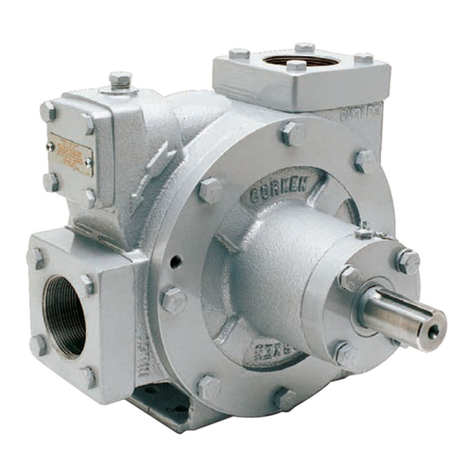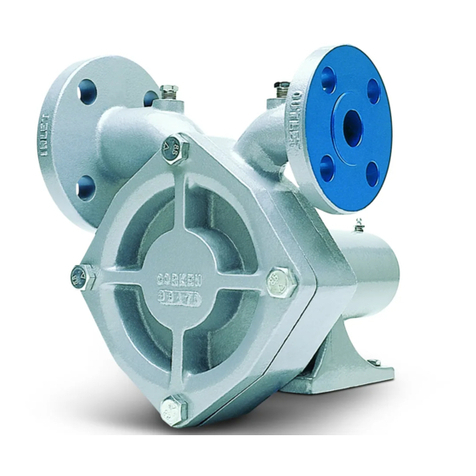
1.11 Wire Sizing Chart—DL-, DLF-, DS-,
DSF-, F-, and FF-Models
Motor Recommended wire size, AWG1
Hp Motor
Phase
Volts Approximate Full
Load Amperes
Length of Run (ft)
0–100 to 200 to 300
3 1 115 34.0 6 4 2
230 17.0 12 8 8
3230 9.6 12 12 12
460 4.8 12 12 12
5 1 115 56.0 4 1 1/0
230 28.0 10 6 4
3230 15.2 12 12 10
460 7.6 12 12 12
7-1/2 1230 40.0 8 6 4
3230 22.0 10 10 8
450 11.0 12 12 12
10 3230 28.0 8 8 8
460 14.0 12 12 12
15 3230 42.0 6 6 6
460 21.0 10 10 10
20 3230 54.0 4 4 4
460 27. 0 8 8 8
25 3230 68.0 2 2 2
460 34.0 6 6 6
30 3230 80.0 1 1 1
460 40.0 6 6 6
40 3230 100.0 2/0 2/0 2/0
460 52.0 4 4 4
50 3230 130.0 3/0 3/0 3/0
460 65.0 2 2 2
1Based upon 3% voltage loss copper wire type TW. Single phase motor
calculations are based on two times distance.
Chapter 2—Operation of Your
Coro-Flo
®
Pump
The following steps should be performed for the initial
pumping operation:
1. Close shutoff valve on the end of the delivery hose.
2. Open the storage tank bottom shutoff valve.
3. Open the storage tank shutoff valve of the bypass
system.
4. Check the motor for the proper voltage. (See
instructions in section 1.9 Driver Installation.)
5. Start the pump and circulate liquid through the bypass
system.
6. Adjust the B166 bypass valve by turning the adjusting
screw out until the pump pressure gauge shows
nearly the same pressure it did before you started the
pump. Screw the adjusting screw in until the pressure
gauge indicates the pump is starting to lose discharge
pressure (you will know this by the rapid fluctuating of
the pointer); then back the adjusting screw out a turn or
two until the pressure gauge again indicates a steady
pressure. Lock the lock nut, and permit the pump to
circulate liquid for a half hour or more. If the motor
overload protection device stops the motor during this
period, this indicates the bypass system valve is set too
high and should be readjusted by turning the adjusting
screw out until the motor will run for this period.
2.1 Filling New Cylinders and Tanks
All new containers are full of air and since air will not
liquefy under reasonable filling pressures, it must be
purged. To assure relatively easy filling and the proper
gas supply to burners and carburetors, purging air from
new containers is essential.
Some cylinders are difficult to fill because they are
equipped with a fill tube that extends down into the liquid
portion of the container. If possible, these cylinders
should be refitted, so the incoming liquid enters the
vapor section of the cylinder. If refitting is impossible or
impractical, rock the cylinder as it is being filled so that
liquid will splash up into the vapor section – this will help
keep the cylinder filling pressure down to a reasonable
limit. Don't blame your pump for not filling a small
container! A properly fitted cylinder and filling manifold
or connection will permit filling with not more than 50 to
60 psi differential pressure.
2.2 Pumping From Underground Tanks
The pumping of boiling liquids, like LPG and other
liquefied gases, offers a unique set of challenges for
underground tank installations. The Coro-Flo pumps
give superior performance in these applications if the
system is well designed to function with the pump in
mind. Liquefied gases are stored at exactly their boiling
points. Any increase in temperature, as well as any
decrease in pressure, will cause the product to boil and
form vapor. To minimize the amount of vapor formation
at the pump’s suction, the design of the suction piping
system is an important aspect. For boiling liquids, the
net positive suction head available (NPSHA) of an
installation is reduced to the height of the liquid level
above the pump minus the frictional losses. For an
underground tank where the pump is located above
the liquid level, the net static suction head becomes
the net suction lift, which is negative not positive. This
means that for aboveground pumps pumping from
underground tanks, the installation NPSHA will always
be negative, and the pump will always handle vapor in
the liquid stream.
The Coro-Flo regenerative turbine pumps are designed
to handle some vapor without the damaging effects of
cavitation. They are designed with a floating impeller which
minimizes wear and noise in these types of applications.
Properly installed, Coro-Flo pumps will provide excellent
service in underground tank applications.
8
































